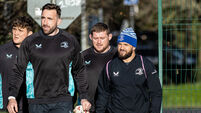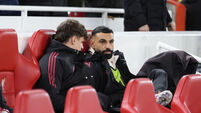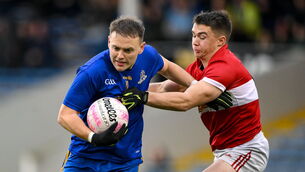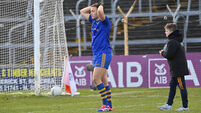Cork’s winter of discontent has no parallels

It’s been a rough few weeks and months for Cork GAA.
Just to refresh your memory, a rough timeline starting late last year would include but not be limited to the following events.
The departure of Eamon Ryan as a Cork senior football selector; the revelation in the Irish Examiner of the size of the Páirc Uí Chaoimh debt; the departure of Ciaran O’Sullivan as a Cork football selector; the departure of Gary Keegan as an adviser to the Cork hurling squad; the departure of the entire U20 football management; an injunction taken out by now-departed senior administrator Diarmuid O’Donovan; and finally, the spectre of club levies to pay off the Páirc Uí Chaoimh debt being acknowledged by GAA director-general Tom Ryan just last week, when he also said the final figure for said debt will be “significantly more than envisaged”.
The headaches come thick and fast. Where to begin?
Well, this year’s first meeting of the Cork County Board was last Tuesday, and an account of the meeting was published on the board website, which is a welcome development.
However, that account failed to reflect the fact that several clubs raised the matter of Diarmuid O’Donovan’s employment at the meeting, which rather undercuts its value as a record of proceedings.
Thankfully those exchanges were reported by this paper, which underlines the need for objective journalism and being there, though this is a different debate.
Full disclosure: Diarmuid O’Donovan has been a friend of this columnist for many years, but that doesn’t invalidate some obvious questions.
For instance, the workload of new CEO Kevin O’Donovan — according to the original job advertisement — includes responsibilities as disparate as “serving as an ex officio Director of Páirc Uí Chaoimh and managing the relationship between the County Committee and Páirc Uí Chaoimh” and “overseeing and strengthening existing strategic and commercial partnerships while developing new relationships with relevant third parties”, not to mention “providing support to inter-county management teams” and last, but not least, “overall responsibility for fixtures planning, in conjunction with the Competitions Control Committee”.
Take the last item: fixtures, which amounted to almost 900 games in total last year.
The board took a tough line last week about ending a culture of (match) postponements, but it is inevitable in a county with over 200 clubs that delays and deferrals will occur, never mind the scheduling problems arising from Cork’s intercounty commitments.

Kevin O’Donovan’s in-tray already looks pretty full before encountering a big spreadsheet with teams and venues pencilled in and crossed out all over it.
Is it even humanly possible to engage in “overseeing and strengthening existing strategic and commercial partnerships while developing new relationships with relevant third parties” and to take up other time-consuming responsibilities while also trying to settle disputes between two clubs about where to play a junior football championship game?
There’s a strong argument for having someone to look after those hundreds of fixtures, but if the board informed Diarmuid O’Donovan that his role — which involved looking after fixtures — was coming to an end, it’s difficult to see the logic in appointing someone new to fill a similar role.
It has to be said that the Cork County Board’s winter of discontent has no parallels in this writer’s experience.
It is an unwelcome distinction, one which sets them apart from other administrative bodies within the GAA.
In Cork these events are the new normal, a shambolic litany, an ongoing, rolling indictment.
Incidentally, if anyone in Cork thinks that the county’s borders form a natural boundary for the effects of recent catastrophes they are sadly mistaken.
The erosion of Cork’s political power within the GAA and the isolation of its officials is already underway, and the next embarrassment, whenever that happens, will only accelerate the process.
The Game hits the big screen for a special cause
Public service announcement: this weekend there’s a showing of The Game, last summer’s hit hurling documentary, in the Dundrum Town Centre.
The screening will be followed by a panel discussion involving some of those featured in the documentary — the discussion will be chaired by RTÉ Sport’s Clare MacNamara — and the proceeds from the evening will go to the future development and promotion of underage camogie in the local GAA club, Ballinteer St Johns.
Your columnist’s involvement in making The Game may compromise my impartiality, but it also allows me to signal that a fourth episode of The Game is down for broadcast this May.
Best of luck to those doing God’s work in Ballinteer St Johns - details here.
Positive thinking could aid football
During the week someone brought up the state of Gaelic football in a conversation and asked me what I would do to improve the game as a spectacle.
“There’s your first problem right there,” I said.
“You’re looking for a spectacle. Who said a spectacle had to be provided?”
I took the point, though. There’s no-one sitting down and saying that what they really want to see - more than absolutely anything - is a 0-8 to 0-7 game in, say, the McKenna Cup.
Even if you allow for the impact of poor playing conditions at this time of year it can be a tough watch.
As Dr Johnson said of your usual Tyrone-Armagh arm wrestle, none ever wished it longer than it is. (Alright, strictly speaking he meant Milton’s Paradise Lost.)
In last week’s Examiner podcast I said there was too little experimentation with the playing rules of hurling, not too much, and the same could be said of Gaelic football.
I wrote last weekend that hurling could benefit from playing 13-a-side, but Gaelic football would be revived out of all recognition: the resemblance to rugby league would be eradicated overnight.
The resemblance to rugby union could be accentuated, however: the willingness to increase the value of a try to four points in 1972 and then five in 1991 should be an example to Gaelic football, not a disincentive.
Why not boost the value of a goal to four points, or five, in one of those pre-season tournaments to encourage attacking play?
The changed face of journalism
I am currently not talking to one of my acquaintances (no longer a friend) because he persists in crowing about his access to a new documentary, Breslin and Hamill: Deadline Artists, access that I sadly lack.
Jimmy Breslin and Pete Hamill hover in an elevated zone somewhere near journalistic Valhalla.
They inhabited and embodied New York City when it was New York City, to quote the great Buck O’Neil.
Of course, the lads’ great heyday of the seventies and eighties is now only a distant memory.
The documentary brings this home with a shocking figure: in 1988, the New York Daily News, which Hamill and Breslin both worked for, employed 400 reporters and editors.
Last year that number was 45.













